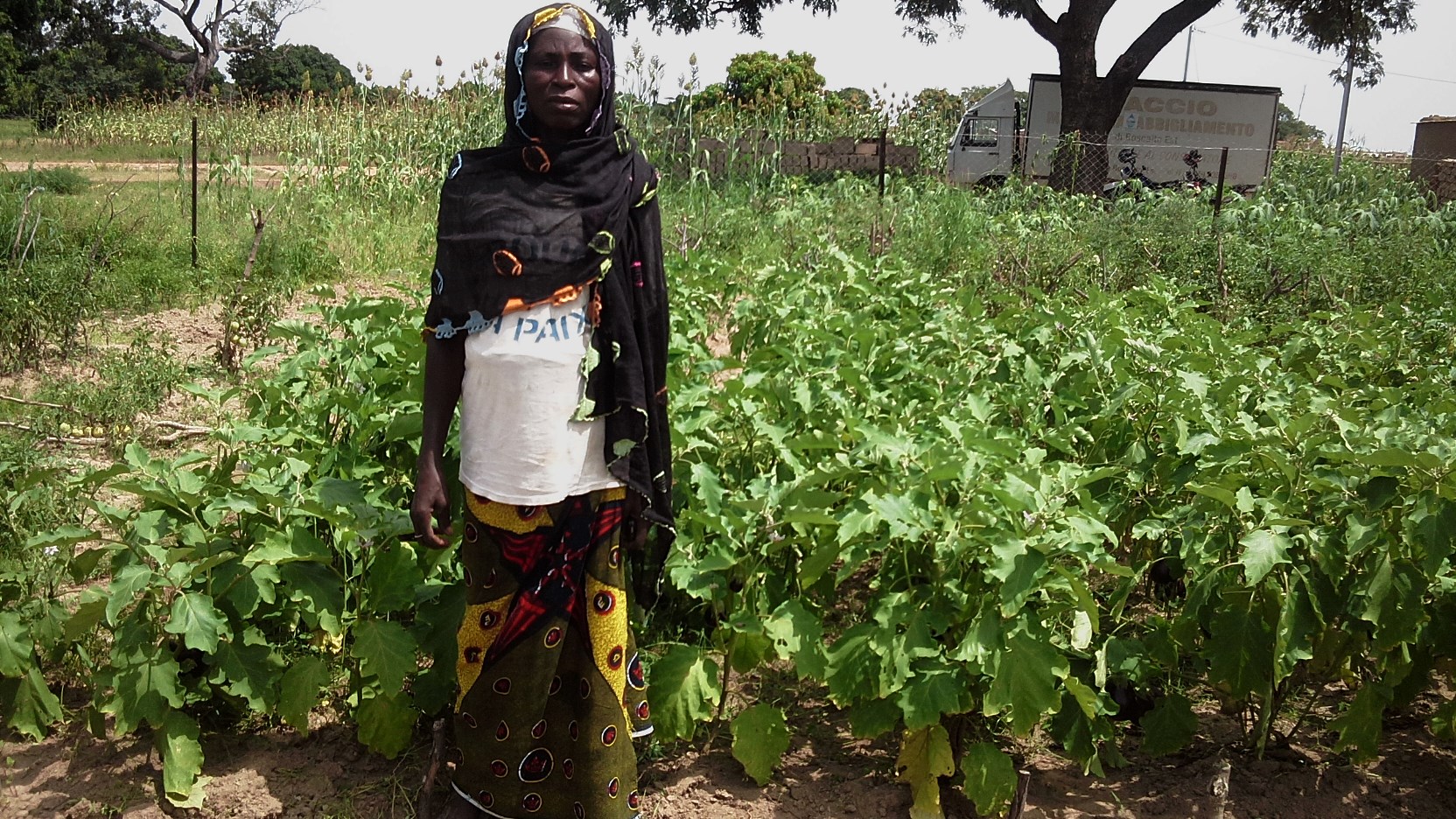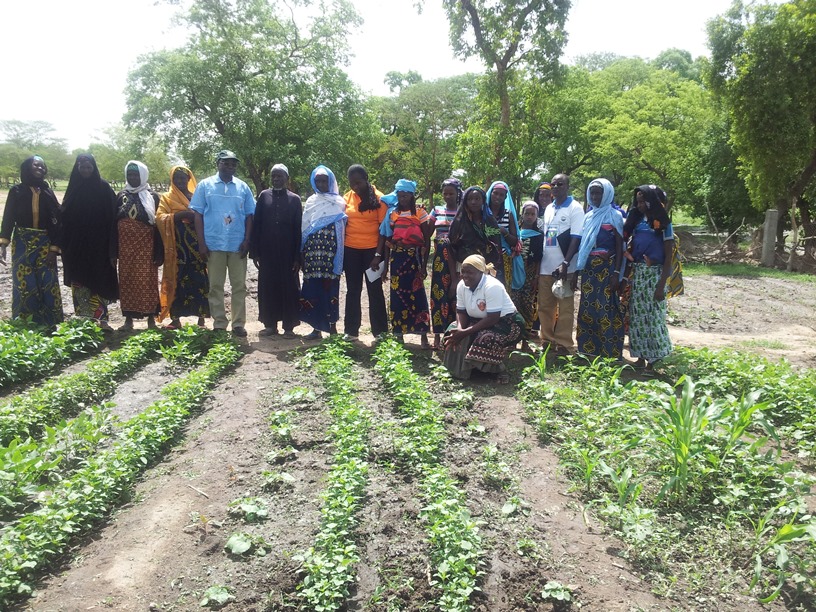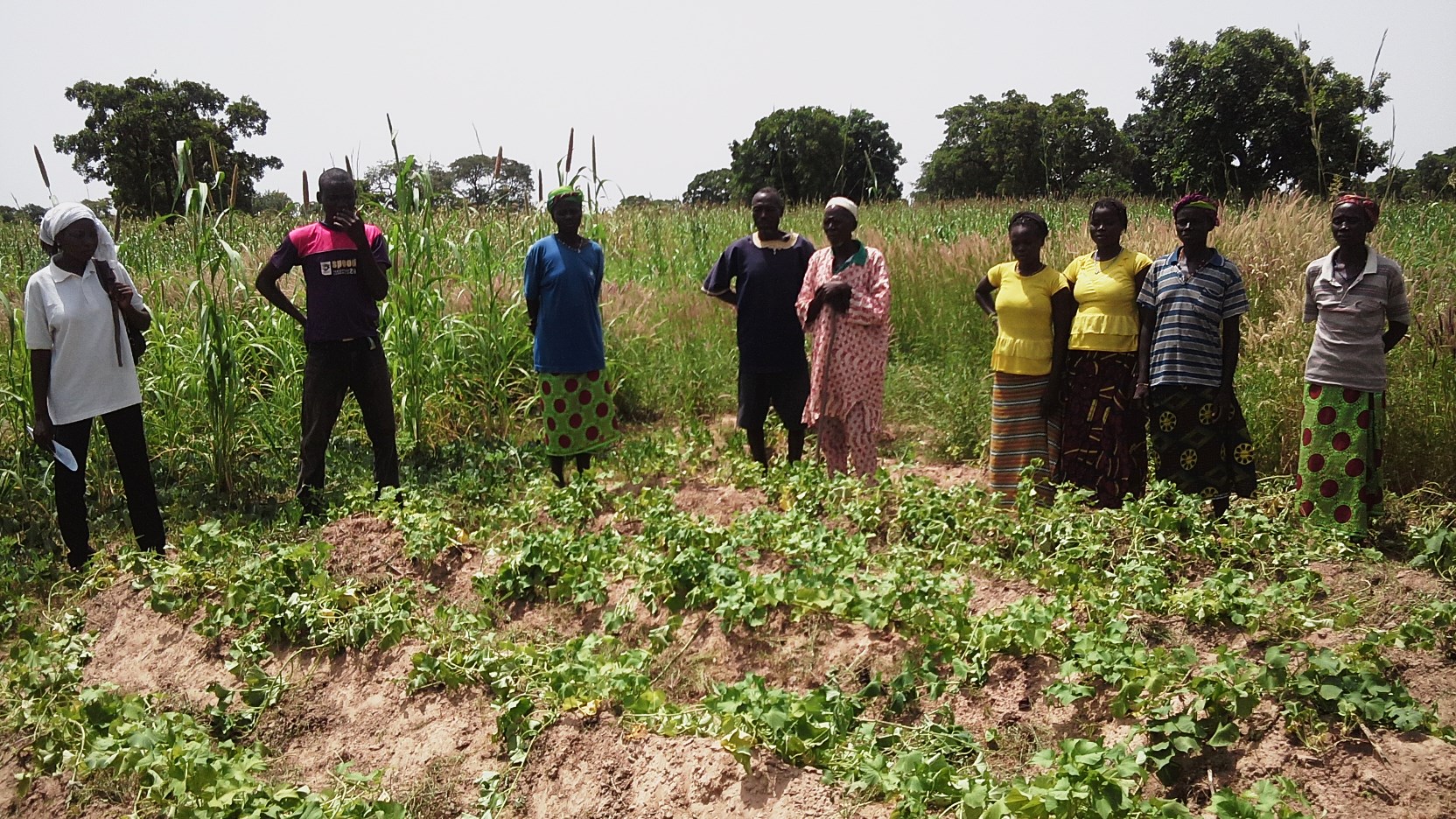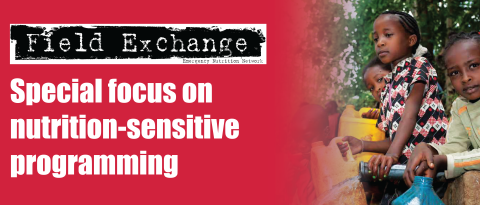Implementation challenges and successes of an AG4Nut project in the eastern region of Burkina Faso
By Marcellin Ouedraogo, Régina Khassanova and Fanny Yago-Wienne
Marcellin Ouedraogo has been in charge of food security projects at Helen Keller International Burkina Faso since 2009. He is currently overseeing the day-to-day implementation of the CHANGE project and several other Ag4Nut projects.
Régina Khassanova is the head of nutrition programmes at Helen Keller International Burkina Faso and ensures the quality implementation of all nutrition-related activities. She joined HKI in 2008 and has extensive experience in community management of acute malnutrition.
Fanny Yago-Wienne is the Helen Keller International Burkina Faso Country Director. She joined HKI in 2010 and has extensive experience in the implementation of health development projects, in particular in the field of nutrition.
The authors acknowledge the support of the Canadian Department of Foreign Affairs Trade and Development (DFATD), the U.S. Agency for International Development/Office of Foreign Disaster Assistance (USAID/OFDA), International Food Policy Research Institute (IFPRI) for leading the research component, and Association d’Appui et de Promotion Rurale du Gulmu (APRG), a local community-based organisation that has contributed to community level implementation.
Location: Burkina Faso
What we know: Undernutrition remains a significant public health concern in Burkina Faso. Evidenced interventions are needed to programme effectively.
What this article adds: An established HKI homestead food production project in Burkina Faso (CHANGE) that targets women is being studied in a randomised control trial (RCT) over three years. Experimental arms include addition of water, sanitation and health (WASH) behaviour change and preventive distribution of LNS to children aged 6-23 months. Experiences from the village model farm (VMF) indicate good community buy-in and greater diversity in foods produced and consumed, including increased consumption of Vitamin A-rich foods and animal-source foods among children. Challenges relate to water access, women’s legal access to land, high illiteracy rates and sustainability. RCT results will be available December 2016.
Context
 Undernutrition remains a significant public health concern in Burkina Faso. According to the 2014 SMART survey, 8.6% of children are acutely malnourished and 29.1% chronically malnourished. The situation is even more worrying in the eastern region (9.4% wasting and 37.7% stunting). Micronutrient deficiencies are particularly alarming: 61.9% of women of child-bearing age and 83.4% of children are anaemic (ENIAB, 2014). Furthermore, it is estimated that 7% (EDS, 2003) of pregnant women suffer from night blindness and that between 26.8% (Aguayo & Baker, 2005) and 46.1% (Micronutrient Initiative/UNICEF, 2004) of children under five suffer from Vitamin A deficiency.
Undernutrition remains a significant public health concern in Burkina Faso. According to the 2014 SMART survey, 8.6% of children are acutely malnourished and 29.1% chronically malnourished. The situation is even more worrying in the eastern region (9.4% wasting and 37.7% stunting). Micronutrient deficiencies are particularly alarming: 61.9% of women of child-bearing age and 83.4% of children are anaemic (ENIAB, 2014). Furthermore, it is estimated that 7% (EDS, 2003) of pregnant women suffer from night blindness and that between 26.8% (Aguayo & Baker, 2005) and 46.1% (Micronutrient Initiative/UNICEF, 2004) of children under five suffer from Vitamin A deficiency.
To address this issue, HKI has been engaged in an Ag4NUT project1 supporting food production strategies for improved nutrition in this region since 2009. The CHANGE (Creating Homestead Agriculture for Nutrition and Gender Equity) project funded by DFATD is currently implemented in 60 villages. To assess the model, the programme is being implemented as a cluster RCT, which is being externally evaluated by the IFPRI. The purpose of the study is to assess the long-term impact of the Enhanced Homestead Food Production Programme (E-HFP) implemented by HKI on household food security and nutritional status, as well as the impact of including additional interventions (behaviour change communication promoting optimal WASH practices, malaria prevention, and/or distribution of preventive lipid-based nutrient supplements to children aged six-23 months) in addition to the standard E-HFP model (visit www.clinicaltrials.gov for more details). Thus the aim is to apply a multi-sectoral approach to address the range of obstacles to good health and nutrition simultaneously. The study will run from March 2014 to June 2016. The evidence-based findings will be used to improve the design moving forward and inform advocacy with partner organisations and the Government. This article shares programme experiences to date.
Enhanced Homestead Food Production (E-HFP) approach
The E-HFP approach aims to improve the nutritional status of women and children through homestead agricultural production and behaviour change on essential nutrition and hygiene actions (see Box 1). A VMF is established in the village which serves as a platform for beneficiary women. All women with a child under five are eligible. The VMF is used to acquire improved gardening and small animal husbandry techniques, as well as learn about good nutrition and hygiene practices and recipes for new crops. Sessions are facilitated by lead farmers and male and female community workers. The project promotes formal community agreements to ensure women’s access to land for the VMFs and makes men aware of the potential benefits. Consequently, women are granted long-term control of a plot of land in the community and receive support of men and community leaders.
Four female Village Leader Farmers (VLFs) are chosen by each village. HKI trains these leader farmers in improved techniques for agriculture, animal husbandry, health, nutrition and hygiene. The leader farmers then share this knowledge with about 40 other beneficiary women organised into women’s groups and supervised by project field staff. HKI provides tools, necessary infrastructure such as fencing, starter kits of seeds and planting materials, along with hens and a rooster, to establish the VMF. The ultimate objective is for each farm to become self-sufficient, procuring these items without project support, within two years. Each VLF has a small plot within the community plot and produce from that plot belongs to her. The produce from the common plot is used for cooking demonstrations, seed production and sales (proceeds are saved in an account to support ongoing costs).
Box 1: EHFP
- A communal garden or VMF is established in each village, including infrastructure such as a well when possible.
- In this VMF, women learn improved gardening and animal husbandry practices.
- Interactive nutrition education improves their understanding of the causes of malnutrition, including suboptimal health, hygiene and nutrition behaviours, and potential solutions.
- Women are encouraged to establish individual gardens and to apply improved infant and young child feeding and hygiene practices within their families.
- Gender empowerment activities support more equitable intra-household decision-making. Activity examples include group discussion with men and community leaders to improve women’s access to land, and improving women’s capacity to manage income resulting from surplus production.
- As a result, participants cultivate micronutrient-rich foods, improving dietary diversity of children and families, combatting malnutrition and improving child health and growth.
 When they have mastered the new production techniques, beneficiary women are encouraged to establish an individual garden and apply the techniques at household level. Those who have established individual gardens have fresh micronutrient-rich foods available almost year-round, most of them very close to the homestead. Produce includes dark green leafy vegetables (spinach and other traditional leaves, jute mallow, baobab), carrots, orange-flesh sweet potatoes (OFSP), beans, sesame, moringa, okra and eggs. The leader farmers and other trained volunteers, such as grandmothers (who have an important influence on childcare practices in these communities), continue to support the women with group discussions on nutrition and hygiene topics. They also conduct home visits to support small, doable changes in nutrition and hygiene practices that fit the reality, aspirations and needs of households.
When they have mastered the new production techniques, beneficiary women are encouraged to establish an individual garden and apply the techniques at household level. Those who have established individual gardens have fresh micronutrient-rich foods available almost year-round, most of them very close to the homestead. Produce includes dark green leafy vegetables (spinach and other traditional leaves, jute mallow, baobab), carrots, orange-flesh sweet potatoes (OFSP), beans, sesame, moringa, okra and eggs. The leader farmers and other trained volunteers, such as grandmothers (who have an important influence on childcare practices in these communities), continue to support the women with group discussions on nutrition and hygiene topics. They also conduct home visits to support small, doable changes in nutrition and hygiene practices that fit the reality, aspirations and needs of households.
The community-led total sanitation (CLTS) approach is also used to improve sanitation and community hygiene practices (visit www.communityledtotalsanitation.org for more information). CLTS, first developed by Kamal Kar in Bangladesh in 1999, is a methodology for mobilising communities to eliminate open defecation – a key element in the disease-spreading cycle of faecal-oral contamination. Since simply providing toilets does not guarantee their use, CLTS focuses on the behavioural change needed to ensure sustainable change in practice. This is achieved through a series of awareness-raising activities to create disgust about open defecation and motivate a community to undertake collective change. Hygiene committees are set up and hygiene agents are identified by the communities to perform outreach and household visits, during which they urge households to take key actions, such as construction of latrines and hand-washing stations, and to reinforce the importance of hand washing.
In one of four experimental arms of the RCT (new EHFP; old EHFP+WASH; new EHFP+WASH; old EHFP+WASH+LNS distribution (old EHFP are projects implemented since 2010; new EHFP are those implemented since 2013)), HKI is also providing lipid-based nutrient supplement (LNS) in 15 villages to all children six-23 months for an 18-month period (start at six months and continue to 23 months). This approach is being tested based on the experience that food-based approaches may not be sufficient to reduce the high burden of micronutrient deficiencies, in particular anaemia. Every month, beneficiary children receive a supply of LNS to allow daily consumption of one 20g sachet; distribution is at the community level but overseen by health workers from the nearest health centre. During the distributions, children are screened for acute malnutrition and suspected cases are referred to the health centre for diagnosis and treatment if necessary. In addition, these events provide another occasion for reinforcing nutrition messages and for organising demonstrations of recipes for nutrient-dense complementary foods based on garden production and other locally available ingredients.
To ensure high quality results, activities are regularly supervised by field agents from HKI and by agents from community-based organisations, as well as government agriculture, health and animal husbandry offices trained by HKI. These partners also actively participate in the project-steering committee that meets every quarter.
Lessons learned and successes
Monitoring to date suggests that CHANGE is contributing to increased production of nutritious foods and improved nutrition practices, which in turn is expected to improve nutrition and health status in participating households. Reinforcing the links between agriculture and nutrition is an explicit aim of the model and is ensured by village farm leaders and grandmothers. After almost three years of implementation, the following outputs have been delivered:
In total, 2,494 direct beneficiaries have been trained in improved gardening and animal husbandry techniques through 60 VMFs established in an earlier phase. Project staff and partners have supported local VLFs, community health workers and grandmothers to reach more than 2,000 beneficiary women each year with Essential Nutrition and Hygiene Actions (ENA-EHA), using the model farm as a platform to gather, debate and encourage participants to take their newly-acquired knowledge home. More than 2,700 home gardens have been created in the project area, extending the availability of fresh micronutrient-rich vegetables from only three months per year to almost year-round.
Salmata Zidwemba, a beneficiary farmer from Kalwatinga village: “In the dry season [when few vegetables are available], I would prepare for her a dish with fresh vegetables from my garden. Impressed, she would taste it and ask, ‘How can you have all these vegetables in the dry season?’ This would convince her to visit my garden and learn to do the same.”
The project emphasises safe and sustainable production techniques, including bio-pesticides and organic fertilisers, which can be produced from ingredients that are easily available in these communities. It also supplies drip irrigation systems to reduce the labour burden on women and on water resources. As Sana Azaratou, one of the beneficiary women from Abaza village reported following training, “Organic fertiliser is very important! My soil is weak and the crops don’t do well without it”.
The activities of this project are attracting the attention of other community members. Project staff have noticed spill-over to non-beneficiary households in both intervention and non-intervention villages, who have begun growing vegetables at their homes, feeding their children more diverse and nutritious foods and using improved nutritional practices. They too decided to set-up home-gardens, established plots on their own and requested training to help them produce properly. In response, HKI mobilised resources and provided training to an additional 1,200 women. This effect is particularly encouraging and suggests that the project is meeting a felt need in these communities.
Project-monitoring data also suggest that sales of surplus production have enabled the mothers to improve the family diet by purchasing high-value foods that are not produced in the garden or to cover other crucial expenses such as health or school fees. This has also increased women’s influence over important household decisions. OFSP, which is particularly rich in beta carotene and promoted by HKI and others to address vitamin A deficiency, is observed as being increasingly cultivated in household gardens and VMFs. Many households now own more than 20 chickens and are feeding eggs to young children: According to latest monitoring data, about 80% of children under five consume eggs regularly. Monitoring data also shows that 92% of women are consuming leafy greens, 92% of children consumed meat and poultry product and 65% of children ate fruit and other vegetables rich in Vitamin A during the previous seven days. It also appears that the income generated by the selling of the surplus is allowing women more autonomy in expenditures for children’s health and education.
The results to date of the CLTS activities are also very encouraging. The approach is conducted in 45 villages by hygiene committee members trained by HKI, who monitor latrine construction and promote good hygiene practices among the community. In the words of Djaneiba Naba, the chair of one of these committees: “For me, there aren’t things that are difficult to change; there are just things that we don’t know about yet. Like with latrines, we used to think they were just too expensive to build; now we know this is within our reach and the men have already started digging. The rest will come in time.”
The CLTS approach has been integrated into a nutrition-sensitive agriculture approach to increase the impact on child nutritional status. Infections increase nutritional needs while reducing nutrient uptake. Environmental enteropathy, in which constant faecal-oral contamination results in changes to the intestines, significantly impacts absorptive and immunologic functions. It is thus fundamental to tackle hygiene and nutrition at the same time to achieve the expected results.
Monitoring results suggest that while nutrition knowledge and practices are improving, more efforts are needed in areas such as feeding the sick child and the integrated control of anaemia. Men appear increasingly convinced that home gardens contribute to family health and are encouraging their wives to continue the gardening activities during the rainy season, when staple crops are usually given priority. Men are also contributing by investing in henhouses of more durable materials.
The project is guided by a steering committee comprised of various stakeholders, including representatives from the regional and provincial directorates of agriculture, animal husbandry, environment, women’s promotion and health as well as local community-based organisations. During the quarterly meetings, achievements and challenges are discussed and recommendations provided to improve the project implementation and to find solutions to problems related to the local context, give advice and make decisions if necessary. These partners are also closely following project progress through periodic field visits. The mechanism is helping to build ownership of the project that should continue after external support ends.
Challenges
The major challenge of implementing an agriculture-oriented nutrition project in Burkina Faso, and in particular in the eastern region, is access to water. Water is fundamental not only for gardens but also optimal hygiene. If gardens must be watered by hand using distant sources, the labour burden may have unintended negative consequences on women’s and family health. Drip-irrigation systems are only a partial solution, as in some locations silt levels in the water lead to clogging. The hard and rocky soil also makes digging latrines more arduous.
 More approaches are needed to strengthen women’s legal access to land. Currently the garden plots do not belong to women and can thus be repossessed at any time. Encouraging evolutions in community norms have been observed (Van den Bold, Pedehombga et al, 2013) but much still needs to be done in this field. It is also important to be vigilant to make sure the additional responsibilities for gardening are not detrimental to child-care activities. It is even more challenging to reconcile production objectives and child wellbeing during the rainy season, when mothers are staying in the fields far from health facilities while the risk of malaria and diarrhoea diseases increases. During the rainy season the family relocates to focus on staple crop production, making it difficult to reach beneficiaries with project training and behaviour change activities and LNS distributions.
More approaches are needed to strengthen women’s legal access to land. Currently the garden plots do not belong to women and can thus be repossessed at any time. Encouraging evolutions in community norms have been observed (Van den Bold, Pedehombga et al, 2013) but much still needs to be done in this field. It is also important to be vigilant to make sure the additional responsibilities for gardening are not detrimental to child-care activities. It is even more challenging to reconcile production objectives and child wellbeing during the rainy season, when mothers are staying in the fields far from health facilities while the risk of malaria and diarrhoea diseases increases. During the rainy season the family relocates to focus on staple crop production, making it difficult to reach beneficiaries with project training and behaviour change activities and LNS distributions.
The contributions of the community relays are considerable. However, high levels of illiteracy pose significant challenges in Burkina and the ability to learn is limited among illiterate community relays. Images are used in job aids as much as possible, but abstract concepts are more difficult for low-literacy volunteers to understand and master. Routine project reporting is also often weak.
Finally, sustainability remains a major challenge in the local context. The project has endeavoured to create a supportive enabling environment, building the capacity of individuals as well as institutions, and experience suggests that positive outcomes can be achieved with limited external supports. Continued engagement of local authorities and the recognition of their contribution to the fight against malnutrition will be crucial to fully hand over the key project activities.
Conclusions
The experience in Burkina Faso shows that integrating nutrition and agriculture into a multi-strategy and cross-sectional approach project is an essential ingredient to fighting the multiple and interrelated determinants of undernutrition. Monitoring data must be used to increase the effectiveness of such interventions and evaluation data will provide more evidence of what works best.
For more information, contact Regina Khassanova, tel: +226- 25 36 00 23 or Marcellin Ouedraogo, tel: +226 25 36 00 23
References
Aguayo V.M., & Baker S.K., (2005) Food and Nutrition Bulletin 26 (4): 348-355, Vitamin A deficiency and child survival in sub-Saharan Africa: A reappraisal of challenges and opportunities.
EDS, 2003. Enquête démographique et de Santé.
ENIAB, 2014. Enquête national d’iode et d’anémie.
Micronutient Initiative/UNICEF, 2004. Vitamins and minerals: A global damage assessment.
Van den Bold M., Pedehombga, A., et. al. (2013) IFPRI Discussion Paper 01315 Can integrated agriculture-nutrition programs change gender norms on land and asset ownership? Evidence from Burkina Faso.
Footnotes
1An Ag4Nut Project seeks to realign existing agricultural approaches and encourage new ones in order to better meet the nutritional needs of the target population.


